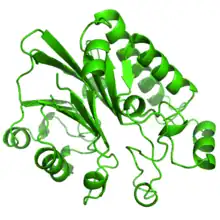Exonuclease III
Exonuclease III (ExoIII) is an enzyme that belongs to the exonuclease family. ExoIII catalyzes the stepwise removal of mononucleotides from 3´-hydroxyl termini of double-stranded DNA.[1] A limited number of nucleotides are removed during each binding event, resulting in coordinated progressive deletions within the population of DNA molecules.[2]
| Exonuclease III | |||||||
|---|---|---|---|---|---|---|---|
 | |||||||
| Identifiers | |||||||
| Organism | |||||||
| Symbol | xthA | ||||||
| Alt. symbols | ExoIII | ||||||
| Entrez | 946254 | ||||||
| RefSeq (Prot) | NP_416263 | ||||||
| UniProt | P09030 | ||||||
| Other data | |||||||
| EC number | 3.1.11.2 | ||||||
| Chromosome | genome: 1.83 - 1.83 Mb | ||||||
| |||||||
Function
The preferred substrates are blunt or recessed 3´-termini, although ExoIII also acts at nicks in duplex DNA to produce single-strand gaps. The enzyme is not active on single-stranded DNA, and thus 3´-protruding termini are resistant to cleavage. The degree of resistance depends on the length of the extension, with extensions 4 bases or longer being essentially resistant to cleavage. This property is used to produce unidirectional deletions from a linear molecule with one resistant (3´-overhang) and one susceptible (blunt or 5´-overhang) terminus.[3]
ExoIII activity depends partially on the DNA helical structure[4] and displays sequence dependence (C>A=T>G).[5]
ExoIII has also been reported to have RNase H, 3´-phosphatase and AP-endonuclease activities.[1]
Current Studies
There are many different exonucleases and many are still to be discovered in bacteria, current studies are being conducted in E. coli. Many exonucleases fall into superfamilies with different domains of life proving that exonuclease III has shown to be ancient. Exonucleases evolved early in the history of life and have vital biological roles.[6]
Regulation
Temperature, salt concentration and the ratio of enzyme to DNA greatly affect enzyme activity, requiring reaction conditions to be tailored to specific applications.
References
- PDB: 1ako; Mol CD, Kuo CF, Thayer MM, Cunningham RP, Tainer JA (March 1995). "Structure and function of the multifunctional DNA-repair enzyme exonuclease III". Nature. 374 (6520): 381–6. Bibcode:1995Natur.374..381M. doi:10.1038/374381a0. PMID 7885481. S2CID 4335526.
- Image rendered in MacPyMOL©2006 DeLano Scientific
- Rogers SG, Weiss B (1980). Exonuclease III of Escherichia coli K-12, an AP endonuclease. Methods in Enzymology. Vol. 65. pp. 201–11. doi:10.1016/S0076-6879(80)65028-9. ISBN 978-0-12-181965-1. PMID 6246343.
- Maniatis T, Sambrook J, Fritsch EF (1989). Molecular cloning: a laboratory manual (2nd ed.). Cold Spring Harbor, N.Y: Cold Spring Harbor Laboratory. pp. 5.84–5. ISBN 978-0-87969-309-1.
- Henikoff S (June 1984). "Unidirectional digestion with exonuclease III creates targeted breakpoints for DNA sequencing". Gene. 28 (3): 351–9. doi:10.1016/0378-1119(84)90153-7. PMID 6235151.
- Lovett ST (December 2011). "The DNA Exonucleases of Escherichia coli". EcoSal Plus. 4 (2). doi:10.1128/ecosalplus.4.4.7. PMC 4238392. PMID 26442508.
Further reading
- Richardson CC, Lehman IR, Kornberg A (January 1964). "A Deoxyribonucleic Acid Phosphatase-Exonuclease from Escherichia coli. II. Characterization of the Exonuclease activity" (PDF). The Journal of Biological Chemistry. 239 (1): 251–8. doi:10.1016/S0021-9258(18)51775-0. PMID 14114851.
- Linxweiler W, Hörz W (August 1982). "Sequence specificity of exonuclease III from E. coli". Nucleic Acids Research. 10 (16): 4845–59. doi:10.1093/nar/10.16.4845. PMC 320823. PMID 6752885.